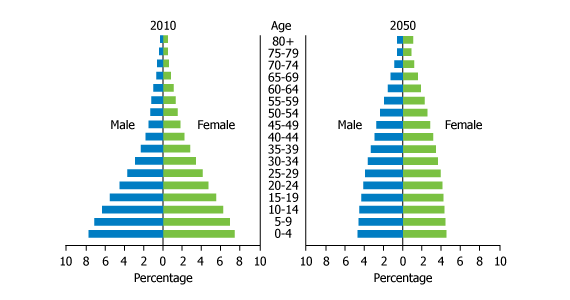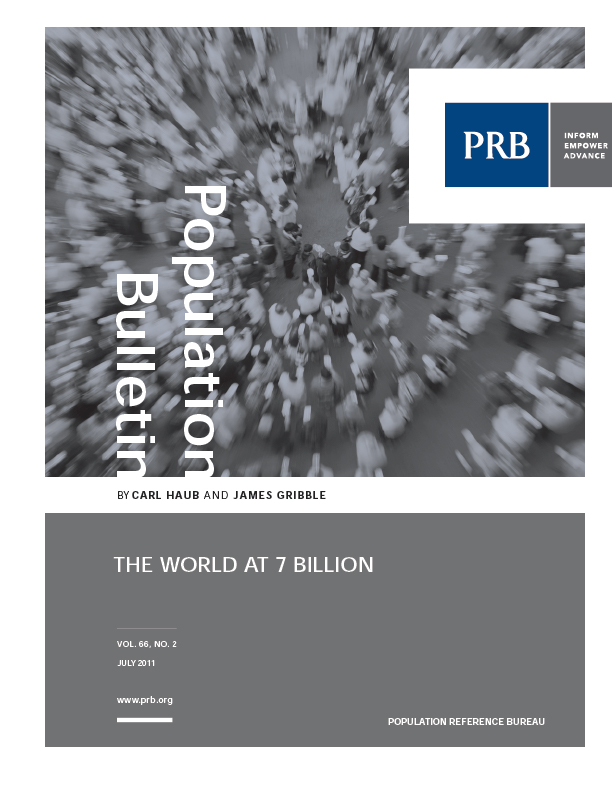
Guatemala: Beyond the Early Phase of the Transition
Date
July 15, 2011
Author
This article is taken from the Population Bulletin:The World At 7 Billion, which looks at the four phases of the demographic transition as descriptive of past and future population growth. Four countries are highlighted to illustrate each phase and its implications for human well-being.
(July 2011) As a lower middle-income country, Guatemala is well-advanced in its demographic transition, showing evidence of recent reductions in its birth rate.
Guatemala’s population structure illustrates that women have been having fewer children for several years, which explains why the base of the pyramid is shorter, compared to the elongated base of Uganda’s pyramid. With half of its population age 19 or younger, Guatemala’s population is still relatively young and is the youngest in Latin America. Guatemala is one of many countries in this second phase of the demographic transition; together they represent about 7 percent of the world’s population of 7 billion.
Overview
At more than 14 million, Guatemala is the most populous country in Central America. Its growth rate is still high at 2.5 percent per year—the highest in all of Latin America. Although Guatemala has several national policies that support social development and address population issues, they have not been carried out very effectively. The country has experienced economic growth in the past decade, although growth has recently slowed. Guatemala remains challenged by high levels of inequality, especially between the Mayan population, which represents approximately 40 percent of the country’s population, and the ladino population, which makes up the majority of the remaining 60 percent.
Guatemala has made great strides in addressing many of its gender-based disparities. However, the more-telling difference is between the quality of the lives of Mayan and ladina women, reflected in differences in school attendance and use of health services. Women are having smaller families; people are healthier and living longer, with a life expectancy at birth of 71 years; and the child dependency ratio is decreasing, suggesting that families may be poised to invest more in health, education, and savings. Nevertheless, sustaining economic growth and dealing with an upturn in violent crime threaten Guatemala’s longer-term development.
Age and Sex Structure of Guatemala, 2010 and 2050

Source: United Nations Population Division, World Population Prospects: The 2010 Revision (2011).
Population and Policies
Over the past 20 years, fertility levels have decreased substantially in Guatemala. From 5.6 children per woman in 1987, the recent 2008/09 National Survey of Maternal and Child Health (NSMCH) indicates that women have an average of 3.6 children each. If current fertility remains unchanged, Guatemala’s population will double in 26 years. Although fertility has gone down, women indicated that, on average, they want fewer than three children.
The recent reductions in fertility are due largely to increased use of family planning. Currently, 44 percent of married women use a modern family planning method, with female sterilization and injectable contraceptives the most common types. At the same time, an additional 31 percent of married women want to postpone or avoid pregnancy but are not using an effective contraceptive method.
Since 2002, Guatemala has had a national Social Development and Population policy that prioritizes as health objectives a reduction in maternal and infant mortality, sexually transmitted infections, and HIV/AIDS. In 2010, the Guatemalan Congress approved a law to support healthy motherhood, and stipulates that at least 30 percent of taxes on the sale of alcohol should be used to support reproductive health programs. Guatemala is also addressing poverty reduction through Mi Familia Progresa, a conditional cash transfer program established in 2008 that encourages the use of health services and education.
Economic Inequalities
Guatemala’s recent economic growth has resulted from tourism and the exports of textiles, clothing, and agricultural crops. Half of the labor force works in agriculture. Almost a quarter of the population lives on less that US$2 per day. The country has a very inequitable income distribution: The wealthiest 20 percent (quintile) of the population holds 58 percent of total income, while the poorest quintile holds only 3 percent.
Economic inequalities influence many social behaviors. Wealthier women have fewer children on average during their lives than poorer women have: 1.8 children per woman in the wealthiest quintile compared to 5.7 children per woman in the poorest quintile. It is not surprising that use of family planning methods is very high among married women in the wealthiest quintile—72 percent—but only 36 percent of married women in the lowest quintile use any form of family planning.
Gender Inequalities
Compared with many other countries, Guatemala has moved closer toward gender equality. Between 1987 and 2008/09, the percentage of women who never attended school dropped from 38 percent to 20 percent; among Mayan women, this improvement was even more notable: from 67 percent never attending school in 1987 to 35 percent not attending school in 2008/09. Recent educational advances are fairly equal for both boys and girls. Among children ages 5 to 14, there are no differences in the age at which boys and girls start school nor in the percentage who never attend school.
Gender roles also influence social behaviors and attitudes. Many Guatemalan women tend to have more traditional views. For example, 65 percent of women included in the 2008/09 survey reported that a woman should obey her husband even when she does not agree with him. Almost 80 percent responded that they need to get his approval before incurring a household expense, working outside the house, going to the doctor when ill, or leaving the house. However, only 56 percent indicated that a woman should seek the man’s approval about using family planning. Each of these attitudes was more frequently held by women in the poorer quintiles than in the wealthier ones.
Gender-based violence is not unusual, as 46 percent of women reported that they have experienced either verbal, physical, or sexual violence from their husband or partner. The frequency of these behaviors is consistent between Mayan and ladina women, as well as across wealth quintiles. However, in contrast to other countries where women accept wife beating, only 7 percent of Guatemalan women agreed that under certain circumstances a man is justified in hitting his wife.
Health of Women and Children
As a country with improving access to and use of health services, Guatemala still has a high maternal mortality ratio of 110 deaths per 100,000 live births, putting it slightly above other countries in Central America. Use of antenatal care is very high, with 93 percent of women receiving care at some time during their most recent pregnancy. More than 50 percent of women receive care from a physician or nurse during delivery, but only 30 percent of Mayan women receive skilled care, compared to 70 percent of ladina women.
Deaths among children under age 5 continue to decrease, from 109 in 1987 to 42 in 2008/09. More than half of infant deaths (17 out of 30 deaths per 1,000 live births) occur in the neonatal period; death at this phase can be prevented through skilled attendance at deliveries and antenatal care. Almost half of all children between ages 3 months and 59 months are stunted (low height for age.) However, almost twice as many Mayan children are stunted as are ladino children (66 percent vs. 36 percent, respectively). Just under half (48 percent) of children ages 6 months to 59 months are anemic, but this condition is fairly evenly distributed across wealth quintiles and ethnicity groups.
Challenges
Guatemala has made great advances in social and economic development in the past two decades, but serious inequities still exist between the Mayan and ladino populations. Regardless of the issue considered—fertility, child health, education—the disparities between these two segments of the population represent the gap that must be addressed through future development initiatives. If Guatemala follows the medium projection scenario, it will have a population of almost 32 million by 2050, and an age structure similar to Phase-3 countries.
Previous: Phase 1: Uganda: At the Beginning of a Transition
Next: Phase 3: India: On the Path to Replacement?

 ">
">





